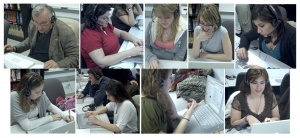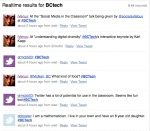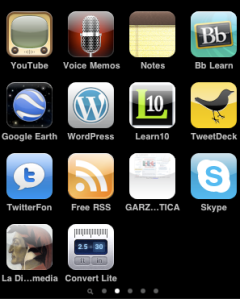Time to share what a wonderful experience this semester’s e-twinning project with Seth Dickens at Martino Martini has been, and in particular the final culminating technological project, the Skype calls.
Over the semester, as mentioned in a previous post, Seth and I introduced our students to Twitter to give them an opportunity to interact and engage in conversations related to topics covered in our courses this semester. Initial tweets were very encouraging and many students exchanged opinions and perceptions about a range of themes from passions to politics (in Italy aren’t they one in the same? 😉 ) and some usual daily chatter.
Seth and I arranged to conclude the project with a video conference followed by one-to-one Skype sessions for our students…how could we not provide them an opportunity to “see” one another after months of tweeting? Seth’s excellent post is a thorough and well thought out overview of the organization and what went well and not so well for us. I whole-heartedly agree with his take on technology and overzealous teachers giving too much to focus on for the task and not enough time to feel free to chat in the L2. 😉
The group hug
Affectionately termed this by AJ Kelton, MSU’s Director of Emerging Instructional Technology, this opening activity gave us an opportunity to not only see the others but also visualize their lab and get a sense of how they work (technologically speaking). Seth, having everyone group around in front of the webcam was a great idea (my students were already seated in front of their computers so it was hard to take see them all at once).
During the group hug, the large image projected on the SmartBoard was not very clear so beyond the sound issue Seth mentioned, sometimes details were lost…ah, if only we had the best of everything 😉
From a presentation perspective, I think I should have requested my students prepare some relevant information…funny how when you ask people to say something, they become quickly aware that they are in the “spotlight” and then freeze & we need an ice-breaker. Maybe next time, we could have them prepare five bits of relevant and interesting information (name, Skype name, years at MSU, specialization, and…I don’t know, the best thing they ever ate!)
By the way, I have a really unsteady hand and I was holding the webcam, trying to make sure I included all students…what I also included was the ceiling, the main computer at the front of the lab, AJ’s webcam for the Ustream, etc. Next time, we’ll have to place it somewhere so I don’t mess that part up 😦

The one-on-one chats
When I was at Calico in March, I attended @judifranz’s session and adapted her idea/process for Skype chats. The break out into personal chats was something of which I would not have immediately thought so I am very grateful to her for this idea.
I thought this went extremely well for our students. Many students were very engaged in their conversation and I think at this point the nervous excitement just turned to excitement. They chatted for more time than planned or anticipated, which for me was a great treat. Also, their ability to chat and share websites and friend each other on other social network sites was truly awesome. I remember walking around the room with my Flip recorder and thinking to myself that they, most of them being digital natives, have once again impressed with what they can do with technology, esp. if it serves an immediate need (as they did on Twitter in SP08, on Pageflakes in FA09 and now on Skype in SP09).
Only two disappointments from my students’ perspective: 1) some issues with sound on our end made voice chatting impossible so they were required to text chat; and 2) not being able to use video. Unfortunately, due to a shortage of webcams at Martino Martini, my students could not see them. Some of my students, however, did allow for video and they were “seen” during the one-on-one sessions too.
The end of the semester…the beginning of a continued e-learning relationship
As many of you already know, I was tenured in November, so now I can turn my attention to working and researching not according to mandates dictated by some archaic notions of what is expected by university professors (remember publish or perish?) but rather more in line with 21st century learners, personal learning networks/personal web, and the role of technology in foreign language education.
Collaborating, organizing and achieving what Seth and I have with this e-twinning project would have been considered quite insignificant on my tenure application, but is really quite significant in terms of learning and creating connections where none have existed in the past. So I hope Seth and I will continue with this in the fall (so many more exciting projects to develop) and maybe the spring too (what do you think Seth?) 🙂
P.S. A special thanks to Michael and Robyn for their endless assistance before and during the Skype event. I am so lucky to work with such wonderful, gifted and just darn nice people (esp the techie ones!). Grazie infinite *big hug* 🙂
 . Hope you enjoy!
. Hope you enjoy!









